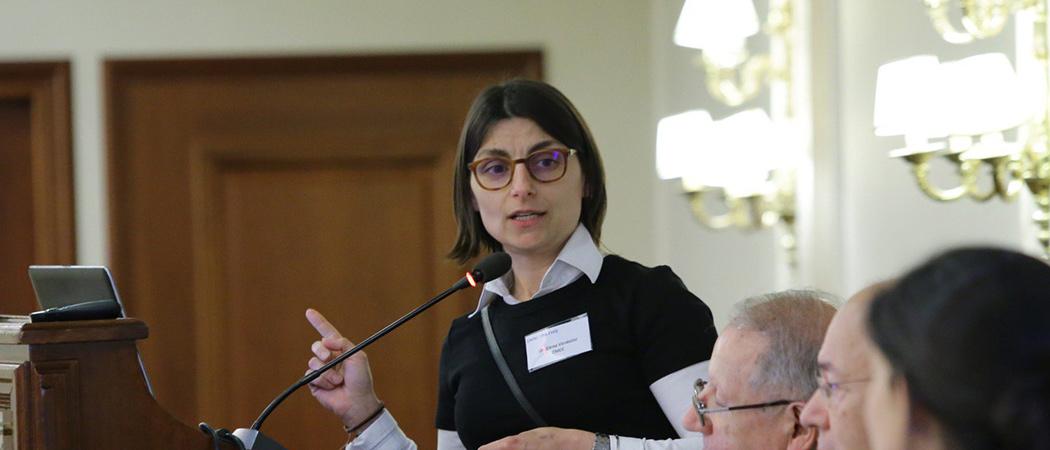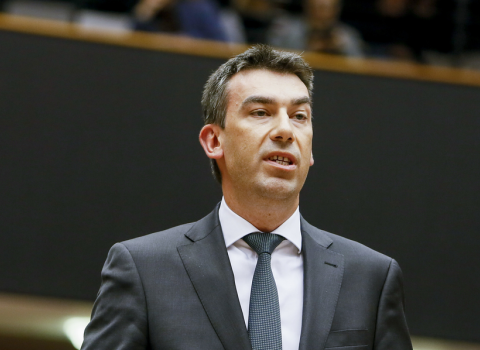Apps for smart electricity grids, artificial intelligence and the Internet of Things promise improved energy management and greater energy efficiency, but ICT’s success could mean the sector’s own carbon footprint gets in the way

Elena Verdolini, Professor of political economy at the University of Brescia. Photo: Twitter @e_verdolini
Digital tools could be one of the keys to Europe’s green future if managed right, and if their own emissions don’t get out of hand.
Studies show that by promoting energy saving and management, digital technologies, such as artificial intelligence, the Internet of Things and smart mobility, can cut up to 15% of global carbon emissions. Others suggest the number could be as high as 20% by 2030.
But experts believe the way these technologies are governed and deployed will determine whether the predictions come true. “Digitalisation will have an impact on decarbonisation one way or the other. Now, the question is, will we be able to harness this potential impact and steer it the way we need it to go,” said Elena Verdolini, professor of political economy at the University of Brescia.
Verdolini is principal investigator for ‘Disruptive Digitalisation for Decarbonisation’, a five year European Research Council-funded project which is attempting to assess how information and communications technologies (ICT) will impact global decarbonisation efforts.
ICT has first to look to itself: official figures say the sector is responsible for 1.8 to 2.8% of global greenhouse gas emissions. Some researchers say the figure is higher and lies somewhere between 2.1 and 3.9%.
The official estimates don’t take into account the full supply chain pathways and miss some of the emerging trends in ICT, with the huge energy demands of blockchain systems for ensuring the integrity of data being one case in point.
“The evidence is lacking on these trends,” said Kelly Widdicks, lecturer in computer science at Lancaster University, who together with her colleagues is working on assessing the ICT carbon footprint. “We try to critique them and find out why they vary,” she told Science|Business.
Taking charge
Believers in the potential of ICT to reduce emissions say empowering start-ups to develop new technologies is the route to achieve reductions through energy savings and custom solutions for tackling emissions.
The innovation agency Business Finland has made this its goal as part of the country’s aim to become carbon negative by 2050. As the first country to carry out a mass roll out of smart electricity meters, it now wants to go further and enable digital tools to bring about a carbon-free future.
“Digitalisation as well as bioeconomy and circular economy principles are the tools to make this change happen. What we say is that 50% of emission reductions needed by 2030 could be tackled by more intense use of digitalisation,” said Helena Sarén, head of the agency’s carbon neutral mission.
On the other side of Europe, start-up, Bamboo Energy from Spain, is aiming to support the energy market with an AI tool that will enable aggregators to automatically manage the flow of energy from intermittent renewable sources such as wind and solar. One way that has been suggested to achieve this, is to use electric cars and domestic solar systems as places to store energy.
“In the past, we generated energy, transported it by power lines and consumed it. This model nowadays is completely changing,” Bamboo CEO Alex Gomar told Science|Business. “[Cars and houses are now] electric batteries in movement.”
The company has received support from the EU-supported innovator network in the energy sector, EIT InnoEnergy, giving it access to connections across Europe. Now, the start-up looking to roll out its product in Denmark, the Benelux countries, Germany, France and UK. “We are currently identifying one or two markets to push forward our solutions,” said Gomar.
“I think that this is not an opportunity, in that it is necessity,” Gomar said. “Entrepreneurs and new technological solutions have to change the rules of the system.”
Being smart
The changes required in applying ICT to smooth the ups and downs of renewable energy won’t come spontaneously.
Sarén cites China as an example of what can go wrong. Despite massive investment in renewables, the country’s green resources are too widely distributed and too volatile to provide a stable energy supply. “It’s bad for inhabitants, business and the process industries. [Doing it right is] something we should pay more attention to,” said Sarén.
For its part, Business Finland is taking lessons from another existential crisis, the COVID-19 pandemic, which made everyone “pick up their collective brain and develop vaccines”, said Pekka Sivonen, head of European collaboration at the agency. The same approach is needed in addressing the climate crisis, he believes. “There’s an awful amount of reinventing the wheel. We are not claiming Finland has all here. Our message is to join forces,” said Sivonen.
The efficiency paradox
For ICT to deliver on its potential to reduce emissions, the status quo has to change. As computers become more powerful and cheaper, more are sold. Despite any improvements in energy efficiency, emissions go up. “Historically, ICT’s environmental impact has increased with efficiencies,” Widdicks told Science|Business.
As Verdolini notes, this is basic economics. “When you make something cheaper to use, the theory predicts that you will use more of it,” she said.
Widdicks believes the only way to reverse this trend is to introduce global carbon use constraints. There are already voluntary industry pledges, such as Microsoft’s commitment to become carbon negative by 2030, and the United Nations International Telecommunication Union’s aim to reduce emissions. But none of these commitments are binding. “Currently, we have this paradox where efficiencies lead to increased emissions,” Widdicks said. “Moving forward, we need to have these more mandatory targets and that are more transparent.”
But currently there is a shortage of data on how ICT is contributing, or not, to the fight against climate change, and on where the balance lies between greater energy efficiency and greater use of ICT.
Verdolini hopes her EU-funded project will collect some of the key missing data to better understand how digitalisation will impact decarbonisation in all its aspects, from the labour force to cutting emissions. She is analysing the impact of digital innovations, such as 3D printing and mobility as a service, in which users can plan and pay for all their transport/travel through a single app, on energy consumption and energy efficiency in the building, transport and manufacturing sectors.
Such fundamental research will be crucial to informing policy decisions going forward. If it is not managed properly, increased digitalisation could lead to inequality, while electronic waste becomes an even bigger problem.
“If we leave it ungoverned, which is what has mostly happened until now, digitalisation may get us in a spiral and pull us away from a sustainable future,” said Verdolini.



 A unique international forum for public research organisations and companies to connect their external engagement with strategic interests around their R&D system.
A unique international forum for public research organisations and companies to connect their external engagement with strategic interests around their R&D system.